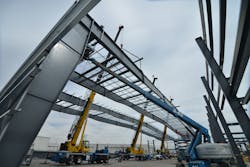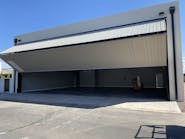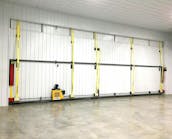Gear Up for Larger Jets at Your Airport Facilities
In the U.S., general aviation aircraft fly over 24.8 million hours, of which two-thirds are for business purposes. In addition, the industry generates $219 billion in total economic output, supports 1.1 million total jobs and contributes $109 billion to the nation’s GDP.
These statistics, provided by the General Aviation Aircraft Manufacturer’s Association (GAMA), demonstrate the important role that airports play in providing a place for business aircraft to serve critical transportation needs and promote economic opportunity.
As aircraft manufacturers invest millions of dollars and create thousands of jobs in local communities, their activities have a ripple effect throughout the U.S. economy. In fact, $23.9 billion in new aircraft were delivered in 2017, representing a 1.3 percent increase in business jet deliveries over the previous year. A major driver of this growth was the introduction of several new aircraft models into service.
As the general aviation aircraft fleet continues to expand worldwide, buyers of private jets who want to fly long distances are welcoming new, larger models. For example, the Boeing Business Jet (BBJ) is approximately 65 percent taller than luxury jets such as the Global Express or Gulfstream V. With a tail height exceeding 40 feet, the BBJ is required by National Fire Protection Association regulations to be housed in a more expansive “Group I” hangar with a more expensive fire suppression system. The aircraft’s extra weight also requires thicker concrete in the hangar floor and apron area.
While not as large as the BBJ, other business aircraft recently introduced to the market include the Gulfstream G650 – which spans approximately 100 feet wide, 100 feet long and over 25 feet high – and the Bombardier Global 8000 – which spans over 104 feet wide, 102 feet long and 27 feet high.
Is there Room on the Ramp?
The introduction of aircraft with larger wingspans offers global reach and ultimate range to private jet travelers. However, it also poses new challenges to general aviation airports that are dealing with aging infrastructures. Hangars that were constructed decades ago are too small, impacting the ability of aviation companies based at the airport to provide the necessary support facilities and services.
New capital improvement projects will need to be designed for aviation facilities that can accommodate the new ultra-long-range jets. FBOs, private owners, and jet charter and management companies will be required to make significant investment to existing leaseholds and facilities. In addition, municipal zoning requirements that regulate building features such as hangar height may need to be revisited and revised – which could result in a lengthy and expensive process at airports.
In addition, it is important to keep in mind that an increased hangar door height also increases the size requirements of the entire structure. To accommodate larger wingspans, the hangar will need a greater column-free area, requiring increased steel support that drives up the cost of construction.
Who Will Pay the Rising Costs?
Finally, airport sponsors must be concerned with meeting the Federal Aviation Administration’s design standards for runway and taxiway widths, as well as runway-to-taxiway and taxiway-to-taxiway separation requirements. In lieu of complete reconstruction, many airports are conducting renovation projects such as widening the taxiway just enough to meet minimum standards.
Regardless of aircraft size, the modification and/or construction of new hangar facilities and ramp space represents a significant investment for airport businesses. Airport sponsors also face the challenges of having a limited amount of space for expansion and meeting current FAA design standards for larger and heavier aircraft.
Who will pay for these improvements? While airports may receive federal Airport Improvement Funds, private equity and venture capital may be the solution for aviation companies seeking to meet operational needs. However, when funding comes from those who are more interested in turning a profit than are passionate about aviation, it may come with a cost that is ultimately borne by the user.
Today, it is more important than ever for airport sponsors, users and operators to collaborate on innovative solutions to accommodate a changing aircraft fleet, while meeting operational needs, achieving cost-effectiveness and providing passengers a superior flight experience.




